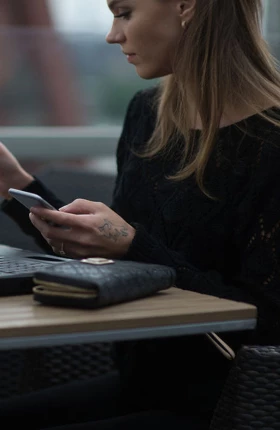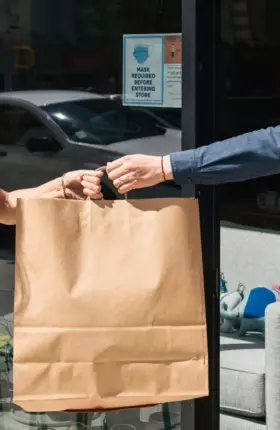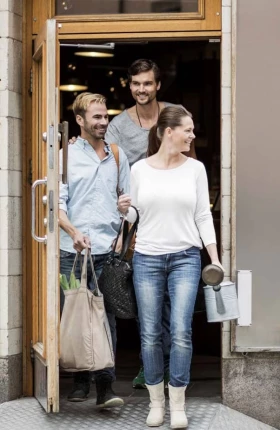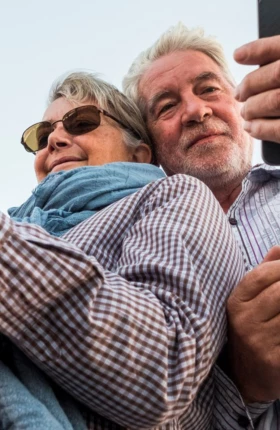Published monthly, the COVID-19 Australian Consumer Sentiment Snapshot highlights information drawn from a BCG consumer survey that we execute every four weeks with our coding and sampling partner, Dynata, supplemented by ethnographic research insights from BCG Platinion. Our research is designed to uncover consumer perceptions, attitudes, and behaviour and spending changes related to COVID-19 as they evolve. This snapshot presents insights from research completed in the Australian market and eight other countries from April 20 to April 24, 2020.
Never has there been such a sudden shock to consumption and such forced changes in consumer behaviour as now. The COVID-19 pandemic has led to near to total shutdowns around the world bringing social and many economic activities to a standstill.
In this uncharted territory, as institutions formulate the roadmap to restart the economy, consumers are gradually reinserting themselves into the ecosystem, adapting purchasing patterns and behaviours as they navigate concerns about the long-term impacts of COVID-19 and adjust to a simpler way of life. Willingness to buy Aussie brands has grown dramatically; institutions at the forefront of the crisis (healthcare, supermarkets and governments) have seen significant and rapid gains in trust. Australians might feel nostalgic for a desire to return to normalcy (which is in line with other countries), and our sense of personal financial security is the best in world (around 60% of us are not worried about our current personal finances compared with 40% in Italy and the US), but consumers’ predicted behaviour says ‘normal’ might be a long time coming.
FEAR OF ECONOMIC RECESSION
Our April 2020 Consumer Sentiment study reveals that 84% of Australian consumers believe that there will be an economic recession post-COVID-19, and 40% of Australians feel financially insecure.
All mature markets show a similar concern over the rate of recovery and whether their spending habits will return to normal post COVID-19, with Australia faring best on personal financial security (refer Exhibit 1). Contrasting with developed countries, Chinese consumers in this time of unprecedented change are more resilient and are already showing a return to normal spending habits.
CHANGES IN SPENDING BEHAVIOUR REVEALS A DRAW TOWARDS A SIMPLER LIFE
While governments and companies are trying to steer consumers away from anxiety-led purchase behaviour, consumer sentiment during the pandemic is likely to have a significant impact on category revival post-COVID-19.
Overall, half of Australians say that they have decreased their spending over the past month due to COVID-19, and a similar number say they expect their spending to decrease significantly over the next 12 months (refer Exhibit 2).

COVID-19 is also steering consumers towards a simpler way of life. BCG’s Global Consumer Sentiment survey suggests that 64% of consumers believe that basic and simple products that do the job are all they need; premium or luxury products are unnecessary. This is illustrated by their planned spend over the next six months (refer Exhibit 3). Consumers told us that they expect to cut spending in both travel (~70% fall) and luxury brands and products (~45% fall) while daily essentials expect a 31% gain. This category take-off curve is similar for other developed nations including the US and UK, while China shows a very different pattern: consumers in China predict they will continue to spend as usual on most of the categories that we tested.

Ethnographic research conducted by BCG Platinion illustrates this retreat to the simpler life further with consumers using the time returned from commuting to pursue creative interests: baking bread, growing vegetables and nurturing gardens, and home maintenance. Our Consumer Sentiment study reveals that 74% of consumers who have cut down on eating-out are cooking meals at home, and one-third of Australians are taking up DIY home repairs.
LOCK DOWN MEANS AN EVEN FASTER MIGRATION TO ONLINE SPENDING
Digital technology use has shown a step change in purchase behaviour with the percentage of consumers who have purchased through digital channels growing from 39% to 76% in the last four years. In the last three months, the number of new digital purchasers increased by a further 3 percentage points as more Baby Boomers (aged 52-66 years) and Silvers (aged 66+ years) came online for the first time. Baby Boomers and Silvers now make up 34% of digital purchasers compared to 25% in 2016.
Even more interesting is the increase in the number of categories purchased online. One in five Australians bought at least one new category online in the last four weeks alone, and the average number of new categories purchased by Millennials and Gen Z segments in the past four weeks was 3.9 compared with 3.2 for Gen-X and 1.9 for the Baby Boomer and Silver segment combined (refer Exhibit 4).

The top 12 categories purchased online for the first time across all age groups include education, preventative health care, takeaway food and medical procedures. Other categories purchased for the first time online varied by generation: Millennials and Gen-Z bought insurance, medical procedures, home renovation products, personal care and pet care products; Gen-X bought children’s clothing, skin care, fashion jewellery and athletic clothing; and Baby Boomers and Silvers bought shoes and footwear, women’s clothing, plants and gardening supplies and fresh fruit and vegetables for the very first time online (refer Exhibit 5).

Australian companies are realising the need to capitalise on this shift in digital purchase behaviour. Accent Group (owners of Hype DC and Platypus retail chains) have announced that they will shut stores after a big leap in online sales, jumping from $250k a day in early March to as much $1.1 million a day during last two weeks of April. In addition, Priceline Pharmacy has rapidly deployed its Click & Collect solution, allowing effective distribution of online orders to customers. Priceline is now exploring options for an automated distribution centre in Sydney to further expedite the online process for consumers.
WHO DO WE TRUST?
The COVID-19 crisis has provided a catalyst for some more fundamental changes in what consumers value, and which brands they most trust.
Our research showed an increased appetite for Australian brands, with 37% of consumers saying they would purchase Australian brands, a 56% increase from 2016. This is despite the premium price perception of Australian brands relative to non-Australian brands. The trade-up for Australian brands will be largely seen in fresh food, packaged food and medicines (refer Exhibit 6).

One of the most interesting aspects of the past four weeks has been the bounce in trust for those institutions seen as essential and at the front line of this crisis. This is best demonstrated by the following chart (refer Exhibit 7).

- Health service providers: What service could be more essential in a time of pandemic than health services? The need for health care services, combined with an increasing number of providers moving to ‘hybrid’ and more accessible models of service delivery (including TeleHealth and drive-through offerings) has seen a net gain in trust for health care providers of 25 percentage points over the past month.
- Supermarkets: We observe significant uplifts in net trust for supermarkets overall, including an 18 percentage point net gain for national grocery chains. Woolworths, for example, has been credited for their response during COVID-19. The supermarket recently launched their Community pick-up service which allows individuals to pick up online orders for themselves or on behalf of community members they are caring for. This solves pain points for customers around social distancing and stock depletion and has built trust among Woolworths’ customers.
- Governments (State and Federal): While consumers we interviewed had mixed views on state and federal governments’ early response to the crisis, over time both levels of government have won the trust of the consumers we surveyed for their response to COVID-19. Net trust gains of 18 and 17 percentage points respectively were observed in the past month.
- Telecommunications providers such as Telstra and Optus created brand equity through targeted acts such as upgrading data plans, adding 20GB-25GB at no extra cost for existing customers, but they showed lower gains in net trust overall.
- Banks and insurers: While we did not observe a net change in trust for banks at an institutional level, the results were quite polarised, with 14% of respondents increasing their trust of banks, and 14% decreasing their trust over the past month. Insurers as a category (including health insurers and general insurers) saw a net decrease in trust. In our next report we will de-average the results for specific brands, as early data suggests a large spread of net trust gains across specific banks and insurers.

With respect to what consumers will purchase, approximately 45% believe that they will reduce their spending on luxury brands and products, post-COVID-19 and ~70% of consumers are expected to cut down spending on travel. Most other categories are expected to return to normal levels of spend post COVID-19 (refer Exhibit 3).
So far, we have explored what consumer behaviours are changing as a result of COVID-19. The next question is, do we expect these behaviours to persist?
It is also interesting to look at how consumers will purchase post COVID-19, and, in particular, whether their migration online will continue. A third of Australian consumers say that they will increase spend on digital purchases post COVID-19, including 34% of Millennials and Gen-Z, and 31% of Baby Boomers and Silvers. Exhibit 8 illustrates which categories will be most affected by continued change in this behaviour. Consumers will increase online spending on travel, savings, insurance, essentials, appliances and essentials.
While it is still early to judge how persistent these behaviour changes will be, it is useful to look to markets like China who are coming out the other side of this crisis, and to past experiences such as SARS as a reference point. Chinese electronics e-tailer JD.com, which rapidly pivoted from its bricks and mortar roots during SARS to become the country’s largest retailer, is a leading example for this pandemic.
Right now in Australia, there’s a long list of ‘new normal’ activities in life under lockdown with the young discovering old ways to connect and the old connecting with the new. COVID-19 has already changed the spectrum of digital users from niche segments to all Australians which will, in turn, create opportunities to offer customers new experiences in the comfort of the home during one of the most unsettling periods in our history.
For example, our Consumer Sentiment report showed that one-third of Australians have used the feature of advanced video calling/chatting in the past month. Consumers are embracing the whole spectrum of digital offerings to live a ‘virtual life’. A happy, first-time digital user we interviewed illustrates this, “I downloaded Pillow to track my sleep. I downloaded Noon to buy things online. I started using Instagram and the Snapchat and Fishbowl apps. Netflix consumption has gone up.”
Companies that can leverage technologies—by meeting changing consumer demands online, enabling seamless interactions through direct-to-consumer offerings and enhancing consumer experience with the human interaction where it is needed most—have the opportunity to earn loyalty well after consumers’ concerns subside.
HOW CAN COMPANIES RESPOND?
- Support your customers through the tough times – show that you care, and understand the challenges they face, e.g., by deferring payments, allowing refunds or deferrals of booked travel and experiences.There are many examples of companies in Australia that have demonstrated their commitment to their customers in these tough times.Qantas made it as easy as possible to get a credit or refund on cancelled flights by proactively contacting all customers whose flights have been cancelled and extending points and airline status expiration dates. Telstra and Optus have delivered 25GB and 20GB of free data for customers respectively. IAG introduced The Help Program, to support NRMA Insurance, SGIO and SGIC Home and Motor Insurance customers who are struggling financially as a result of the pandemic.
- Make it is as easy as possible for customers to meet their initial needs online, and support with offline channels, e.g, use video where a customer needs extra support or prefers human interaction, use phone to coach and guide a customer through their online purchase.Creating digital stickiness for those who struggle to make digital part of their lives is hard. They might require several engagements and ‘practice runs’ to embed the behaviour. One digital learner we interviewed said, “My hurdle is that I need to reinforce that I need to use it and I need to use it a lot. It doesn’t always stick because I might not use it again for three weeks, and that one time being shown it isn’t enough for it to stick, even with notes. Sometimes I lack confidence and I don’t always remember it and I feel having to ask again makes me look stupid.”Online retailer The Iconic’s business model recognises that many consumers are making online purchases for the first time and so made it easy for customers to make the shift with no shipment charges for two business day delivery as well as paid same-day delivery options, free returns for 30 days with return delivery paid, a dedicated online Customer Service Team to help support consumers, attractive deals and discounts.NAB proactively connected with 15,000 passbook holders, some of whom had used their passbook account for 40 years to help them to learn how to do their banking digitally, while ANZ Bank trained ~300 extra staff to assist customers in Australia contacting the bank via digital channels.
- Build trust to grow and retain customers by dynamically striking a balance between transparency and security/data privacy on digital platforms.BCG’s research (The Digital Consumer, 2019) highlighted that data privacy remains one of the most significant concerns for consumers of all ages. Consumers want more control and protection over their data, and there has been a 13 percentage point increase in consumers manually changing privacy settings between 2016 and 2018. Our research suggested that consumers would be more open to sharing their data if they felt there was a fair exchange of value, use of data was transparent and security concerns were met. While the COVID-19 crisis may have forced some to revisit privacy concerns, consumers will continue to look for a balance between value exchange, transparency and security on digital platforms.A good example of trying to strike this balance between customer value and privacy is the Australian Government’s COVIDSafe app. Registration on COVIDSafe requires a minimum of information to be shared (effectively, just a name, postcode, age range and phone number) and high levels of transparency on how this data will be used. Deobfuscation of the code has enabled the Tech community to review the app, and so far it has rated highly for security. While initial downloads numbers have been promising, it remains to be seen if this careful balance is enough to persuade the majority of Australian citizens over the line.
- Help consumers satisfy their need for new experiences, with innovative new offerings, growth in online to offline commerce, and social elements.During recessions and downturns, companies that were able to innovate and invest in growth areas were those that ultimately thrived. For example, Apple released its first iPod in 2001 during a recession in the US when the company saw a 33% drop in revenue. COVID-19 is already prompting an outpouring of creativity in other areas.From Spiderman-esque wrist-mounted disinfectant sprays, to a wristband that buzzes whenever you’re about to touch your face, a wealth of new prototypes are demonstrating what human ingenuity is capable of in the face of adversity.In Australia, high end restaurants such as Nel have been experimenting with home delivered food boxes. Arts institutions such as Recitals Australia and Melbourne Symphony Orchestra have been scheduling live-streamed concerts.Like Apple, companies should rapidly innovate around the biggest pain points for their customers and create new offerings to win post COVID-19.
- Be ready for the return to demand for valued physical experiences.Companies that will win in the wake of the COVID-19 crisis are planning their recovery now. They are ready to ramp up with compelling offers and thoughtful responses to consumer concerns around health and hygiene, such as maintaining social distancing.For example, BCGDV’s Safe@Work app has been developed to allow a safe and fast ramp up of operations and business continuity by closely monitoring critical skill resources and providing targeted information on infection chains in company structures. This will give customers, employees and business partners confidence to deal with these companies as all return to work.
- Rigorously and continuously track customer behaviour and customer feedback across touchpoints, to rapidly identify break-points and opportunities for improvement and innovation.Now more than ever, a robust 360-degree feedback system will help guide companies in their customer responses and opportunities post COVID-19. Best-in-class business systems allow continuous tracking across all customer touchpoints and channels, and combine customer feedback with operational metrics to identify where the biggest lift in service is required to meet customer expectations. It is also critical to use these lead indicators to track when customer demand will recover, so that companies are ready to respond.
NEXT TIME…
The next edition of The Australian Consumer Sentiment Snapshotwill look at the trend in how consumer attitudes, preferences and behaviour change relative to our COVID-19 baseline. We will assess whether consumers start to become more optimistic about their purchase behaviour as COVID-19 restrictions begin to ease, and see whether there is a continued uplift in digital purchase behaviours, or whether consumers return to old habits in some categories. We will also do a deep dive on specific brands when it comes to trust.
About the 2020 Consumer Sentiment Study: COVID-19 edition
The 2020 Consumer Sentiment Study: COVID-19 edition interviewed a sample of over 1000 respondents, representative of the Australian population over 18 years in age. Australian results were compared with results from eight other countries in the same time period (this wave April 20-24, 2020). The study will be repeated every four weeks so that trends can be observed over time.
BCG teamed with Dynata, the world’s largest first-party data and insights platform with a reach that encompasses 62 million consumers and business professionals globally.
Acknowledgments
We would also like to acknowledge Elisse Zarimis, Robert Liu, Rehaab Raza (BCG Platinion) and the BCG Marketing and Editorial teams for their significant contribution.









